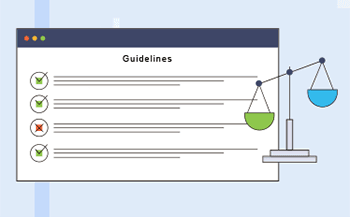What Are Business Rules and What Is Their Importance?
By Mike Raia ![]() | Published May 28, 2019
| Published May 28, 2019
No time to read? Sit back and listen to this post.
Without clear business rules and procedural definitions, a chaotic workplace will often have inconsistent outcomes, poor morale amongst employees, and dissatisfied customers.
Introduction
Suppose you've been a long-term business owner or even a leader in an established business. In that case, you know how chaotic things can get when most decisions are left to fully autonomous employees.
While there is a role for autonomy as it promotes job satisfaction and can help employees grow as they learn to make decisions to better the business, in most cases, at least a core set of understood business rules is critical to help the organization function.
“If you don’t have time to do it right, you must have time to do it over.”
-Unknown
In their simplest definition, business rules are directives that define (or constrain) business activities. Designed to help an organization achieve its goals, those without clear business rules and procedural definitions will often find a chaotic workplace with inconsistent outcomes, poor employee morale, and dissatisfied customers.
The concept of business rules was not born out of the technology era. Instead, business rules were developed or invented through a grass-roots effort to provide the best possible approach to business operations. But, adopting business rules as a broad concept for organizations didn't occur until the early 1990s.
Business rules are now accepted as an underlying requirement of most organizations. They are often used to help prepare system flows or procedural flow charts that outline how a business will operate.
When business rules are made right, they provide efficiency, consistency, predictability, and benefits. They also ensure that work can continue to move forward.
Examples of Business Rules
A broad range of approaches can develop business rules, but the following few points provide fundamental examples to help you understand what we’re getting at:
- A decision-making hierarchy for invoice processing, where the values of specific invoices are tiered to determine which managers can approve.
- Calculations to determine bonus potential and payouts for sales personnel.
- A series of required questions that, if an answer is no, a specific vendor is excluded from a particular partnership opportunity.
- A set of questions and answers for a guest booking a hotel room to determine availability and rates.
 Why Are Business Rules So Important?
Why Are Business Rules So Important?
Effective business rules help set expectations and guide how work will be conducted. Business rules must also ensure an organization abides by local, state, and federal regulatory requirements and guidelines or may address the governance of a specific project.
Organizational leaders often leverage business rules to establish safety in times of conflict resolution, decrease errors, and prevent the need for litigation.
Briefly: Combining Rules with Automation
Business rules alone rely on individuals to follow and enforce them. Combining these rules with an automation platform allows organizations to apply them transparently as part of standard business workflows. For instance, rather than Bob in accounting reviewing invoice amounts and then escalating them manually when a threshold is exceeded, the digitized invoices automatically flow to the appropriate people. This can be applied to any existing business rule part of a business process. We'll cover more on this below.
The Challenge of “Tribal Knowledge” with Business Rules
Most companies have tribal knowledge, which is undocumented information, processes, and rules that exist only in the minds of certain employees. When business rules are not shared widely across an organization and are unwritten, it creates inconsistency in production, processes, quality, and customer/employee experiences. When business rules are not made commonly available to all interested parties, the business subjects itself to a degradation in performance.
Take this example that well outlines the importance of ensuring tribal knowledge is not limited to a select few:
- Imagine an organization with seasonal spikes in business. This could be a retailer that needs to ramp up store staff and customer relations support or even a tax office that needs to bring in additional help to get through the months leading up to April 15.
- Your trainer works to train all of these new resources in short order so that they can hit the floor or workspace and start bringing value.
- But, let’s say a new regulatory requirement about the sales of a specific product to those only over 18 in a particular state. This information is known by the Legal or Regulatory staff who prepare for the change, but it's never communicated to the trainer and thus not passed down to all the new seasonal employees.
- This organization, lacking standardized and well-communicated business rules, could be liable for not following proper rules and regulations when employees fail to screen customers at checkout properly.
In this example, having a central channel to document and, as importantly, communicate rules is the core issue. In many other cases, the problem is simply that only one person knows a rule, and it's taken for granted they'll always be there to provide critical guidance.
But when critical organization-wide information is known to one individual, it can be dangerous. This is the “if you get hit by a bus tomorrow, what would we do?" scenario. Unfortunately, there are unexpected employee vacancies, and businesses must transition from tribal knowledge to documented knowledge and ensure it is put into practice for any business rules that need to inform critical business decisions.
 Types of Business Rules
Types of Business Rules
When defining the types of business rules that most organizations rely upon, it is essential to understand various assertions:
- A structural assertion is one where a fact expresses some aspect of the structure of an enterprise that determines how decisions are made.
- An action assertion outlines a constraint or set of conditions that have some form of control over the actions of the enterprise.
- A derivation is simply an additional element of knowledge that comes from other critical knowledge about the business.
Read more about the history of business rules.
Within the assertions explained above, rules are further defined as one of three types when part of a process:
- Coordination rules—Coordination rules put forward a general requirement that must be met for a process to continue. General statements like "A request must include the department's billing code." These rules help keep a process moving without rework.
- Qualification/ disqualification rules—A set of qualification/ disqualification rules is used when determining if a particular subject should be included or excluded in a process. Think of this as a filtering rule that prevents a lot of wasted time and effort.
- Decision rules—A decision rule is used when a subject needs to be evaluated and assigned the next step. (e.g., approved, rejected, sent back for more information).
Video: What Are Business Rules?
Business Rules Complement Business Processes and Automation
Organizations can often incorporate their business rules into a workflow automation platform that can generate final decisions and offers as part of a workflow. An excellent example of this is in the hotel industry.
When a guest goes online (or even contacts the reservations department by phone), they must provide certain pieces of information to determine if a room is available and to get the rate. The critical information requested is generally the length of stay, the number of guests, and dates for a visit.
Another critical but secondary piece of information is whether or not that guest belongs to that chain's loyalty program and, if so, their history and current loyalty tier. Obviously, the presence of a discount code for a deal package will also impact the rate.
Once the hotel's reservation system has all this information, it can better provide a list of available rooms and at what rate. All of the guest's data feeds the business rules for that hotel chain. These rules are an excellent blend of how decision and qualification rules are used parallel with coordination rules to generate a decision.
Incorporating Business Rules into Your Organization
Organizations have to remember that technology is only part of the solution in today’s workplace, where there are seemingly no limits to the amount of impressive technology designed to improve productivity and efficiency. More important than any piece of technology you decide to purchase is the work that individuals and teams must do to codify the business rules and processes that run the business. Once these rules and procedures are determined and accepted, you can begin to transform the enterprise through automation digitally.
Additional Resources
- What Are Business Rules? (with examples)
- How to write business rules in 7 simple steps
- Wikipedia on Business Rules
- An Overview of Business Rules (Video)
 Thanks to my collaborator on this article, Ann Jarema, a Sales & Marketing Leader by day and business process enthusiast by night. Ann has worked at various business process-related software companies, including Sutherland and FICO.
Thanks to my collaborator on this article, Ann Jarema, a Sales & Marketing Leader by day and business process enthusiast by night. Ann has worked at various business process-related software companies, including Sutherland and FICO.
Categories
Business Ideas Workflow Ideas

Mike Raia
Marketing the world's best workflow automation software and drinking way too much coffee. Connect with me on LinkedIn at https://www.linkedin.com/in/michaelraia/
